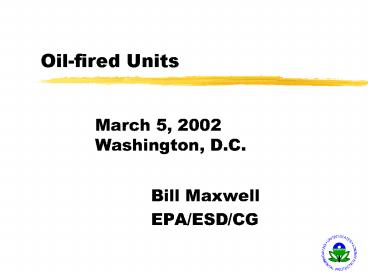Oil-fired Units - PowerPoint PPT Presentation
1 / 10
Title:
Oil-fired Units
Description:
Data posted on website as one file. Databases do not agree 100%. Profile -- continued ... Top 2 units are ESPs with reported PM efficiencies of 92 and 77 percent ... – PowerPoint PPT presentation
Number of Views:40
Avg rating:3.0/5.0
Title: Oil-fired Units
1
Oil-fired Units
March 5, 2002 Washington, D.C.
- Bill Maxwell
- EPA/ESD/CG
2
Where do we stand on oil?
- Profile of the sector
- Status of the data
- What the data tell us
- Where to go from here
3
Limitations of the profile data
- Data not as easy to identify as for coal units
- More multiple fueled units
- Not as much segregation as to what oil is burned
4
Profile of the oil-fired sector
- Used four data files
- EPA E-GRID2000 Boiler and Generator files (data
for 1999) - EPA Score00 files - Emissions scorecard data for
2000 - EIA Tables 8 and 20 (data for 1999)
- Data posted on website as one file
- Databases do not agree 100
5
Profile -- continued
- Estimate on the order of 150 oil-fired units at
70 facilities - Estimated 137 facilities in Final Report to
Congress - Has been a contraction of the sector
- Located in 18 States and the District of Columbia
- Size appears to range from 270 - 9,000 MMBtu/hr
heat input
6
Profile -- concluded
- Controls
- From Final Report to Congress, 1/3 use ESP
- No unit found with FGD system
- Approximately 10-20 may use distillate oil
- Dual-fuel capability
- Difficult to determine as the listing of fuels is
not consistent from file to file - Gas/oil firing significantly more prevalent than
oil/coal firing
7
Status of the data
- Have tests from 13 units, all residual oil-fired
- Inlet/outlet on 4 units
- 3 ESP units
- 1 pilot-scale FF
- 1 SCR
- With/without NOx control on 1 unit
- Outlet only on 8 units
- 20 tests total
- 16 tests essentially uncontrolled
- 4 tests with PM control for metals
8
Assumptions going in
- Nickel is HAP of greatest concern
- CAA section 112(b)(1) lists nickel compounds --
not individual species - FF is not realistic control for oil-fired units
- PM tends to be sticky
- Fouls bags and presents safety hazard
- Not suitable for MACT floor basis
- Leaves ESP as only demonstrated control
9
Finding the floor
- More than 30 units in the sector so could use
top-performing 12 percent of data - Top 12 percent would be top 2 units
- Top 2 units are ESPs with reported PM
efficiencies of 92 and 77 percent - Floor set based on performance of these units
- Looking at individual runs will establish
variability - Some uncontrolled units would be able to meet
level established, depending on the metals
content of the oil fired
10
Where we go from here
- Topics for further investigation
- Availability of low metal oil
- Impact on oil supply and quality of Phase II
sulfur rules - Use of PM as surrogate for metals
- Final floor numbers
- Additional data made available in timely manner
would be considered































